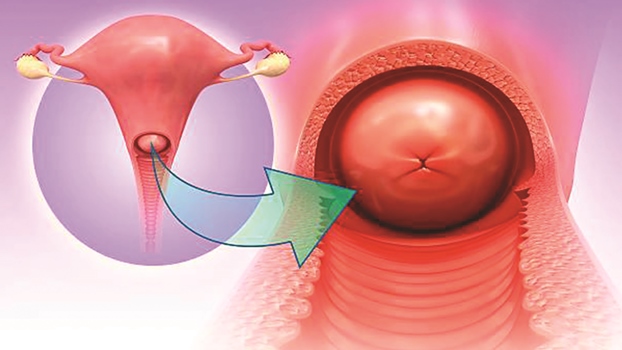Cervicitis Women’s Disease

Dr. Meena Pradhan
What Is Cervicitis?
This is inflammation of the cervix at the lower end of the uterus that opens into the vagina. It can spread beyond the cervix to the uterus, fallopian tubes and into the pelvic and abdominal cavity and cause life-threatening infection. This may cause problem with ‘fertility’ of reproductive age women.
Symptoms
Mostly women with cervicitis comes with complain of white frothy vaginal discharge, low back ache and pain during sex. She also finds difficult, painful and frequent urination or fever, in rare cases. If a woman suffers from lower abdomen pain, vaginal foul smell discharges, painful intercourse and low back pain along with vaginal itching, she may suffer from cervicitis.
Causes Cervicitis
Sexually transmitted diseases (STDs) that include gonorrhoes, chlamydea, genital herpes, trichomoniasis, mycoplasma and ureaplasma may cause this disease. However, many women with cervicitis don’t test positive for any type of infection. Other causes of the inflammation may include allergies (spermicides, douches, or condoms), irritation ( tampons, pessaries, birth control devices such as Cu-T), bacterial vaginosis, and hormonal imbalance having relatively low estrogen or high progesterone may interfere to maintain healthy cervical tissue. Cervical cancer may cause changes to the cervix consistent with cervicitis.
Women with frequent sexual intercourse, multiple sexual partners and have had cervicitis before. Studies shows that cervicitis will recur in 8% to 25% of women who get it.
Diagnosis
On visual inspection doctors see cervical erosion, purulent cervicovaginal purulent white to yellow discolored discharge. Women may refuse per vaginal speculum examination if pain is severe. The doctor would send for cervicovaginal swab culture test to find out bacterial identity. Cervical pap smear is also done to scan pre cancerous state.
According to cervical swab culture test finding included: E.coli, Serratian Marscens, Klebsiella Pneumonia,Staphylococcus aureus, providencia infection, Morganella morgani,Staphylococcus saprophyticus and pseudomonas aeruginosa. These bacterial invasions can cause purulent discharge by proliferation of progeny. Other fungal infection included Yeast cells, Trichomonas, candida species. These fungal infections can cause intense itching that may lead to vulvovaginitis.
Treatment for Mild Cervicitis
1. Medicine such as Tab. Cefixime 200 mg twice daily for five days
2. Tab. Ornidazole 500mg twice daily for 5days
3. Tab. Fulconazole 150mg once at night .
4. Tab. Betadine vaginal pessarey 1 tab insert into vaginal every night for 10 night. Follow up visit would be three monthly to assess cervical condition. Husband/ partner also treated with above medicine as single high dose drugs.
Treatment For Severe Symptoms
Surgical Electro cauterization is the best treatment of choice for moderate to severe chronic cervicitis. Locally doctors gives intracervical plain lidocaine at 12o’clock and 5-7 o’clock position. Electrocauterazation is done to burn out erosive epithelial tissue.
At the end, betadine solution packed gauze is kept inside for 1 hour and remove before discharge from hospital. This procedure is Out patient department (OPD) based so women can go back to work quickly.
Oral medicine is given to prevent further infection for about 5-7 days along with analgesics. Follow up visit would be at first two week interval and second visit after a month of first follow up. During 6 weeks period women is strictly advice to deactivate sexual activity. At that time doctors see significant improvement of women on vaginal discharge and back ache ending up long term painful cervicitis.
This simple procedure is the most effective treatment shown and result is satisfactory. Women’s cervix become completely new and become healthy.
Prevention
The disease is preventable. Some steps that can prevent the disease are:
1. Maintain personal hygiene
2. Wash private part before sex
3. Avoid multiple sex partners (both male and female)
4. Eat nutritious diet and drink plenty of clean water.
5. Regular checkup is necessary yearly for reproductive system scan.
(Dr. Pradhan is an obstetrician and gynaecologist)
Recent News

Do not make expressions casting dout on election: EC
14 Apr, 2022
CM Bhatta says may New Year 2079 BS inspire positive thinking
14 Apr, 2022
Three new cases, 44 recoveries in 24 hours
14 Apr, 2022
689 climbers of 84 teams so far acquire permits for climbing various peaks this spring season
14 Apr, 2022
How the rising cost of living crisis is impacting Nepal
14 Apr, 2022
US military confirms an interstellar meteor collided with Earth
14 Apr, 2022
Valneva Covid vaccine approved for use in UK
14 Apr, 2022
Chair Prachanda highlights need of unity among Maoist, Communist forces
14 Apr, 2022
Ranbir Kapoor and Alia Bhatt: Bollywood toasts star couple on wedding
14 Apr, 2022
President Bhandari confers decorations (Photo Feature)
14 Apr, 2022











